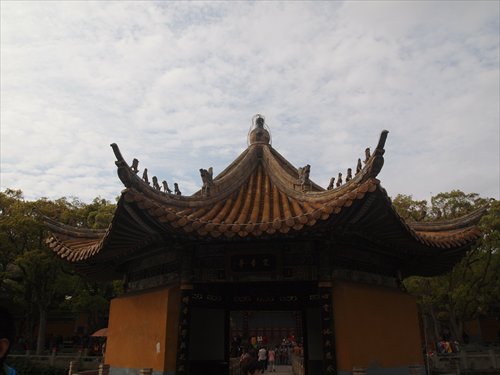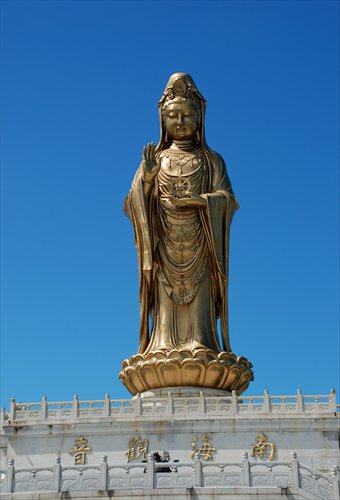Sacred sightseeing
Putuo Mountain offers an insight into Buddhist culture
Whether you go for a spiritual pilgrimage or a sightseeing tour, Putuo Mountain is sure to leave a lasting impression.
Lying only 300 kilometers away from Shanghai, the island is part of the Zhoushan archipelago in Zhejiang Province.
Despite its name, it is not much of a destination for mountain climbers, with the highest peak on the island a mere 300 meters above sea level. But it does offer a look into the complex Buddhist culture of China.
Despite being just 12.5 square kilometers in size with a population of around 4,700, the island is home to more than 200 temples, housing more than 3,000 monks and nuns. They are mostly dedicated to Kwan-yin, a goddess of compassion. In the eyes of many Chinese, Kwan-yin is kind and merciful. People therefore tend to pray to the goddess for health and when trying to conceive a child.
On a Friday afternoon earlier this month, I set foot on Putuo Mountain for the second time, hoping to escape the urban hustle and bustle, get some fresh sea air and eat some just-as-fresh seafood.

A pavilion inside Puji Temple Photos: Ni Dandan/GT and CFP


(From left to right) Wugongshi wharf where passengers take ferryboat to land on Putuo Mountain; A pavilion inside Puji Temple Photos: Ni Dandan/GT and CFP

Wugongshi wharf where passengers take ferryboat to land on Putuo Mountain
My previous visit had been during a national holiday, when there were people everywhere and one had to queue to do almost everything. I learned from this experience, hence my decision was to visit at a less busy time of year.
Puji Temple is one of the island's three main temples, and is only around 1.5 kilometers from the wharf. You can either walk there or take a bus.
Opting to walk means you will get a chance to enjoy the scenery, which include some of the island's greenery. The island is home to more than 60 types of trees, many of which are over 100 years in age.
Even on a work day afternoon, there were many pious worshippers burning incense at the temple. However, it was not overcrowded, and there was plenty of space to burn incense and pay tribute oneself - three sticks are generally regarded as enough to show sincerity and respect. There was a short wait for a cushion to become available on which to kowtow to the statue of the Buddha.
There are certain rules that visitors to a Buddhist temple should follow. For instance, women should step into a temple hall right foot first, but men should lead with their left foot. The first step should be as big a stride as possible. Never step on a threshold, let alone stand on it. When touring a temple hall, a visitor should go around in a clockwise direction.
But many visitors simply have no idea of these rules. Some take photos within the hall, which is usually forbidden in the halls of Buddhist temples.
Built in the 17th century, Puji Temple is the largest temple on Putuo Mountain. Its front door always remains shut. Visitors can only enter and exit through the side doors.
Legend has it that Emperor Qianlong of the Qing Dynasty (1644-1911) ordered that this be the case. On a visit to the mountain, the emperor sought to stay in the temple as night was falling. However, the monk on duty did not believe that this was the emperor, and refused to open the front door.
Out of anger, the next day the emperor issued an edict saying that Puji Temple can never open its front door, although some said the emperor ruled the temple could open its front door - but only once every 60 years.
Another spectacular sight on Putuo Mountain is the bronze statue of Kwan-yin (pictured right). The statue, which is 33 meters tall and was built in 1997, stands by the sea.
It is said that a miraculous event occurred during the consecration ceremony of the statue on lunar September 29, 1997.
It was cloudy on the morning of the ceremony, to the point that raincoats were prepared for the 4,000 present at the event. However, when the ceremony started, a ray of sunshine penetrated the heavy clouds and fell upon the statue. Seeing this spectacle, all those present kneeled. Some said they saw the image of Kwan-yin in the sky.
On the day I was there, I saw some pious Buddhists kowtow after each step they took toward the statue until they reached its base.
According to the Chinese lunar calendar, February 19 marks the birthday of Kwan-yin, June 19 is the day Kwan-yin got the Buddhism tenet, and September 19 is the day when she became a Buddha. As such, crowds on these days can be very heavy.
If you have sufficient time, spending a night on the island is an option to consider, especially as the island becomes tranquil at sunset after the day trippers leave. Staying with a local family means you will be able to try some authentic local seafood dishes, and hear the evening drums and the morning bells of nearby temples.